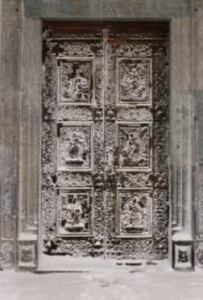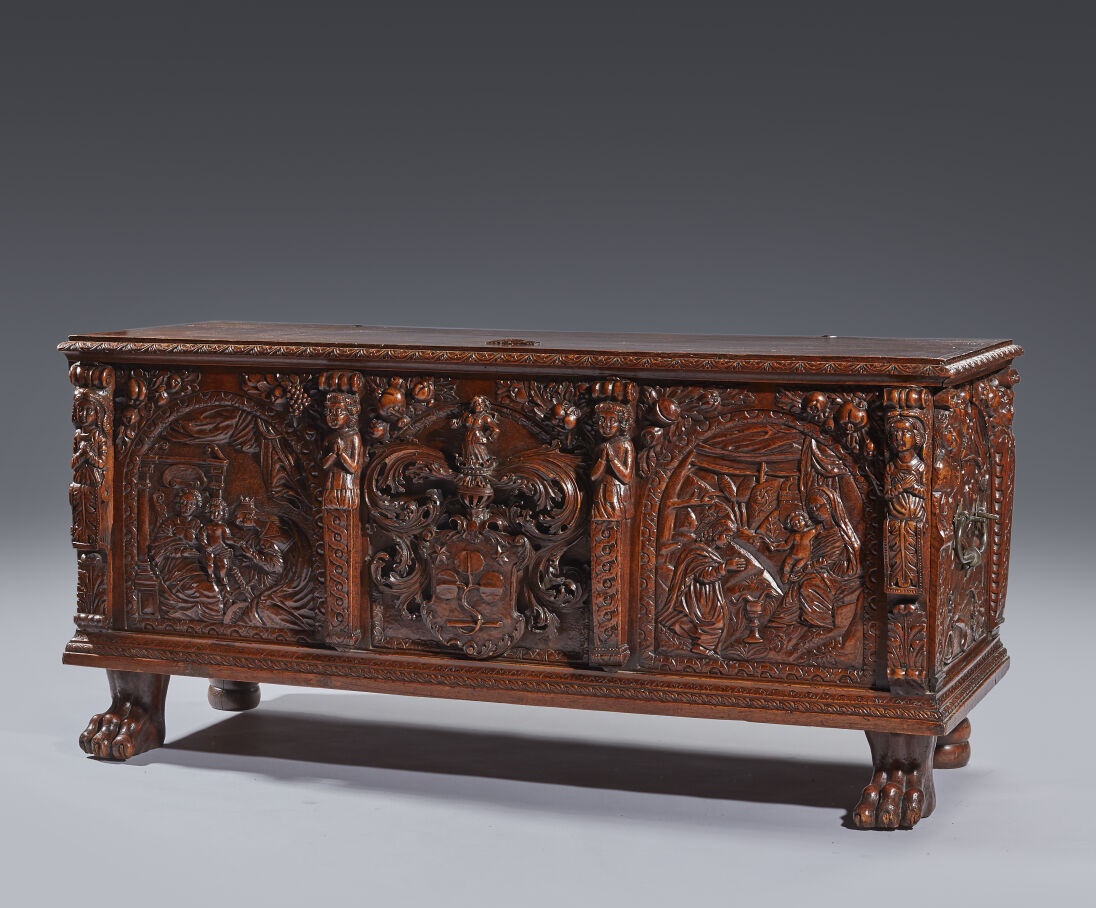Description
The abundance of ornamentation is exalted in this Swiss Renaissance chest with harmonious proportions and generous decoration.
The facade is adorned with three panels framed by four youthful caryatids, draped in pilasters with interlacing motifs. Two Holy Conversations frame the central panel.
This central panel is adorned with a coat of arms consisting of a three-leaf clover topped with two stars, revealing the arms of the RIEDMATTEN Family from the Saint Gingolph branch. On each side of the coat of arms, intricate rocaille motifs emerge. Above, a young woman once held a clover and stands on a pot-shaped, openwork, flame-crowned pedestal, a motif appearing from the late 16th century onward.
On either side, a semi-circular vault bordered by high-relief moldings with semi-rosette motifs presents a scene of Holy Conversation to the viewer. Flowers and various fruit clusters embellish the spandrels.
The Holy Conversation, translated from Italian as “Sacra Conversazione,” is a religious artistic theme that flourished from the 15th century in Northern Italy and Flanders, passing through Switzerland. It is not connected to biblical texts but consists of an extrapolation incorporating a prevalent theme, that of the Virgin in Majesty or a Virgin and Child, as represented here, usually surrounded by Saints and sometimes smaller donors.
On the left, an interior scene unfolds, framed by draped curtains. It is an animated, almost intimate scene, where characters interact. The Virgin, holding the infant Jesus in her arms, sits on a sculpted throne, architecturally structured and topped with a typically Renaissance canopy treated in antique style. The curly-haired Child stands on her knees.
Facing her, Saint Catherine of Alexandria, one of the patron saints of the Canton of Valais (with Saint Maurice and Saint Théodule), kneels in adoration. She holds the hand of the child, bowing before him with her beautiful hair.
She is represented here with her attributes, namely the crown, sword, and the toothed wheel of her martyrdom. A martyr of the 4th century, she refuses to marry the Roman emperor Maximin, who condemns her to the torture of the wheel. Both figures play with the Child, making the scene lively and joyful.
The scene on the right also represents a Holy Conversation. We find the Virgin and Child, and Saint John the Evangelist. This time, the scene takes place outdoors, in a lush enclosed garden with diverse plant species. In this bucolic atmosphere, rocks and a well are depicted in the background.
The Virgin is this time dressed in a veil that extends as an apron over her beautifully pleated dress. The infant Jesus, haloed and in an attitude of joy, presents a sheaf of roses and olive branches to the kneeling Saint John the Evangelist, in prayer. He is represented as a handsome young man with feminine features. Facing him, his attribute, a chalice from which a serpent escapes, symbolizes the trial of the poisoned cup or the triumph of faith.
Saint John the Evangelist represented with a chalice alludes to his testing by the high priest of the temple of Diana in Ephesus. The priest tells him, “If you want me to believe in your god, I will give you poison to drink, and if it does not harm you, then your god is the true God.”
Saint John neutralizes the venom with a blessing gesture as it escapes from the chalice in the form of a small two-headed dragon. The legend tells that Saint John was then able to drink the potion.
This narrative, popularized by Jacques de Voragine’s “Golden Legend,” draws inspiration from phrases in the Gospels. In the Gospel of Matthew, Jesus says to Saint John and his brother, “Indeed, you will drink my cup.” And in the Gospel of Mark, the resurrected Jesus sends the apostles on a mission and promises them, among other things, immunity against poison: “These signs will accompany those who have believed: in My name, they will cast out demons, they will speak with new tongues; they will pick up serpents, and if they drink any deadly poison, it will not hurt them” (Mark 16:17-18).
Saint John the Evangelist is known as the saint who opposed polytheistic cults. Consider this statement of Jesus to Nicodemus: “And as Moses lifted up the serpent in the wilderness, even so must the Son of Man be lifted up, that whoever believes in Him should not perish but have eternal life” (John 3:14-15).
Elaborately worked, the sides of the chest are not neglected. Two large wrought-iron handles adorn the center of a panel covered with scrollwork blossoming with beautiful ivy and olive leaves.
As is customary on Swiss chests, the hinged lid, crowned with a lovely frieze of semi-rosettes, houses a finely wrought and chiseled wrought-iron lock. The hinges joining the back and lid of the furniture are also worked and chiseled, worthy of Swiss workshops already renowned at the time.
The Base
The chest, whose lower border features a frieze of braided leaves surmounted by a second one with semi-rosettes, rests on two lion’s paw claws at the front and two double-flattened ball feet at the back.
This chest, admirably designed and sculpted in various ways in light and deep relief, sometimes in openwork up to the round of the hump, offers richness in terms of subjects, decorations, and ornamentation.
A stained glass window with the arms of Riedmatten (top right), a three-leaf clover topped with two stars, and Montheys is located at the Museum of the History of Valais
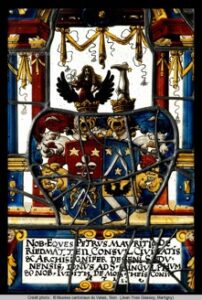
“Stained Glass with the Arms of Riedmatten and Montheys,” in: Elsig Patrick, Morand Marie Claude (eds.), The Museum of History of Valais, Sion. Collecting in the Heart of the Alps, Sion: Museum of History/Paris: Somogy Ed. d’Art, 2013, pp. 186-187.
Bibliography :
Armorial valaisan : Walliser Wappenbuch / hrsg. vom Kantonsarchiv = Walliser Wappenbuch, Archives cantonales (Valais), Zurich : Orell Fuessli, 1946.
Morend, Jean-Claude ; Dupont Lachenal, Léon, Nouvel armorial valaisan. : Neues Walliser Wappenbuch, Saint-Maurice : Ed. du Scex, 1974.
Digital Bibliography on the Coat of Arms of the Riedmatten Family:
https://www.werlen.ch/3985/gommer05.htm
https://core.ac.uk/download/pdf/20661665.pdf
https://doc.rero.ch/record/17328
https://doc.rero.ch/record/17182
https://doc.rero.ch/record/7068/files/I-N177-1958-004.pdf
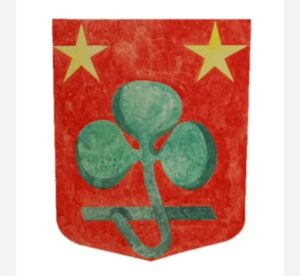
Documentation about the Riedmattten Family
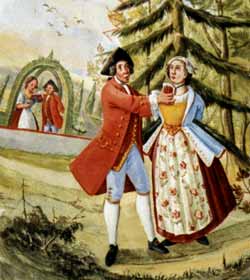
In der von Peter von Riedmatten gestifteten Bielkapelle bei Münster, finden wir dieses Bild. Es trägt die Überschrift: GEFAHR!
THE VON RIEDMATTEN FAMILY
The von Riedmatten come, as their name suggests, from the Riedmatte near Saint-Nicolas in the Vispertal. As the following story shows, they arrived in Münster under extremely unusual circumstances:
A young girl named Margaret Imwinkelried one day went on a pilgrimage to Longeborgne near Sion. On the way, she had to spend the night in an inn in Gampel. At dinner she met a pleasant young man. His name was Adrian von Riedmatten. He was the secretary of Prince-Bishop Matthäus Schiner. The two young people liked each other and spent the night together.
When Margaret returned to Münster, she was pregnant. She didn’t say a word to anyone about her affair, but she persuaded her fiancé Johann Gon to get married immediately.
In the meantime, Adrian von Riedmatten became a priest and later even a bishop. As Margaret lay on her deathbed, she wanted to make her final confession. She confessed that her first son was not fathered by her husband, but by the current bishop. When questioned, the bishop confirmed his statements.
Peter Gon was disinherited by the Gon family and was called Peter von Riedmatten from 1536. This is the incredible but true story of how the Riedmattens were smuggled into Münster!
It was a chance for the village. The von Riedmatten family became the most powerful and important family in the valley. Moreover, the Münstiger line descended from the bishop is the only one that has survived. Peter’s father, the influential prince-bishop, favored his only son with all the means at his disposal. He, in turn, was respected and powerful. Hildebrand, one of his sons, followed his grandfather’s example and became the first bishop of Riedmatten in Münster. From 1565 to 1701 – for almost 150 years – the bishop of Sitten was a Münstiger. Their names were Adrian II, Adrian III, Adrian IV and Adrian V.
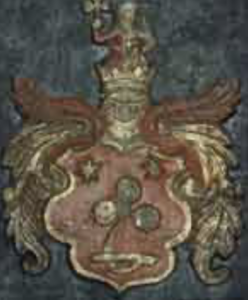
Riedmattten-Wappen
It was a glorious time for the village. This had political, economic and financial advantages. Many taxes and duties flowed into the church treasury.
As Münster and its large parish – which included the 10 Gommer villages from Selkingen to Oberwald – became larger and larger, the ship had to be enlarged. This happened around 1660.
Bishop Adrian V promised to cover the costs of all gilding work when the church was expanded. When the bill was presented to him, he reportedly exclaimed: “For heaven’s sake, you built the whole church in Giltstein!” »
